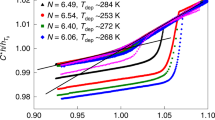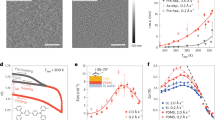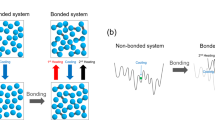Abstract
Glasses are generally prepared by cooling from the liquid phase, and their properties depend on their thermal history. Recent experiments indicate that glasses prepared by vapour deposition onto a substrate can exhibit remarkable stability, and might correspond to equilibrium states that could hitherto be reached only by glasses aged for thousands of years. Here we create ultrastable glasses by means of a computer-simulation process that mimics physical vapour deposition. These stable glasses have, far below the conventional glass-transition temperature, the properties expected for the equilibrium supercooled liquid state, and optimal stability is attained when deposition occurs at the Kauzmann temperature. We also show that the glasses’ extraordinary stability is associated with distinct structural motifs, in particular the abundance of regular Voronoi polyhedra and the relative lack of irregular polyhedra.
This is a preview of subscription content, access via your institution
Access options
Subscribe to this journal
Receive 12 print issues and online access
$259.00 per year
only $21.58 per issue
Buy this article
- Purchase on Springer Link
- Instant access to full article PDF
Prices may be subject to local taxes which are calculated during checkout



 = 0.3.
= 0.3.
Similar content being viewed by others
Change history
13 May 2014
We reported the formation of stable binary glass films by vapour deposition. The results were generated on relatively small samples. Simulations of larger systems carried out after the publication of this work have revealed that a significant fraction of the stabilization effect reported can be attributed to composition inhomogeneities that arise near the interfaces of the films. An analysis of these effects is reported in J. Chem. Phys. 139, 144505 (2013). In particular, the extrapolated cooling rates that would be required to generate ordinary glasses with inherent-structure energies comparable to those of vapour-deposited glasses are approximately 2–3 orders of magnitude smaller than the cooling rates used in traditional liquid-cooling simulations. This number is in contrast to the 19 orders-of-magnitude difference inferred from the smaller samples. Configuration files for the larger systems and the corresponding characterizations are available, and can be provided on request. Furthermore, in the Supplementary Information, in Table T1, the values of the energies EIS and <U>, and the Q6 parameter corresponding to ordinary glasses, and in Table T2, the <U> values, have been corrected to reflect the reported densities. Ivan Lyubimov, from the Institute of Molecular Engineering, University of Chicago, performed the calculations that led to this correction.
References
Angell, C. A. Formation of glasses from liquids and biopolymers. Science 267, 1924–1935 (1995).
Swallen, S. F. et al. Organic glasses with exceptional thermodynamic and kinetic stability. Science 315, 353–356 (2007).
Weber, T. A. & Stillinger, F. H. Local order and structural transitions in amorphous metal-metalloid alloys. Phys. Rev. B 31, 1954–1963 (1985).
Kob, W. & Andersen, H. C. Testing mode-coupling theory for a supercooled binary Lennard-Jones mixture—the van Hove correlation-function. Phys. Rev. E 51, 4626–4641 (1995).
Sastry, S., Debenedetti, P. G. & Stillinger, F. H. Signatures of distinct dynamical regimes in the energy landscape of a glass-forming liquid. Nature 393, 554–557 (1998).
Berthier, L. et al. Direct experimental evidence of a growing length scale accompanying the glass transition. Science 310, 1797–1800 (2005).
Isner, B. A. & Lacks, D. J. Generic rugged landscapes under strain and the possibility of rejuvenation in glasses. Phys. Rev. Lett. 96, 025506 (2006).
Jack, R. L., Hedges, L. O., Garrahan, J. P. & Chandler, D. Preparation and relaxation of very stable glassy states of a simulated liquid. Phys. Rev. Lett. 85, 275702 (2011).
Kob, W., Roldan-Vargas, S. & Berthier, L. Non-monotonic temperature evolution of dynamic correlations in glass-forming liquids. Nature Phys. 8, 164–167 (2012).
Stillinger, F. H. A topographic view of supercooled liquids and glass-formation. Science 267, 1935–1939 (1995).
Sciortino, F. Potential energy landscape description of supercooled liquids and glasses. J. Stat. Mech. P05015 (2005).
Ramos, S. L. L. M., Oguni, M., Ishii, K. & Nakayama, H. Character of devitrification, viewed from enthalpic paths, of the vapor-deposited ethylbenzene glasses. J. Phys. Chem. B 115, 14327–14332 (2011).
Leon-Gutierrez, E. et al. In situ nanocalorimetry of thin glassy organic films. J. Chem. Phys. 129, 181101 (2008).
Jiang, H. & Baram, J. Estimation of the glass transition temperature in metallic glasses. Mater. Sci. Eng. A 208, 232–238 (1996).
Fakhraai, Z., Still, T., Fytas, G. & Ediger, M. D. Structural variations of an organic glassformer vapor-deposited onto a temperature gradient stage. J. Chem. Phys. Lett. 2, 423–427 (2011).
Dawson, K. et al. Highly stable vapor-deposited glasses of four tris-naphthylbenzene isomers. J. Phys. Chem. Lett. 2, 2683–2687 (2011).
Phillips, W. A., Buchenau, U., Nucker, N., Dianoux, A. J. & Petry, W. Dynamics of glassy and liquid selenium. Phys. Rev. Lett. 63, 2381–2384 (1989).
Grigera, T. S., Martin-Mayor, V., Parisi, G. & Verrocchio, P. Phonon interpretation of the ‘boson peak’ in supercooled liquids. Nature 422, 289–292 (2003).
Sastry, S. Liquid limits: Glass transition and liquid-gas spinodal boundaries of metastable liquids. Phys. Rev. Lett. 85, 590–593 (2000).
Sciortino, F., Kob, W. & Tartaglia, P. Thermodynamics of supercooled liquids in the inherent-structure formalism: A case study. J. Phys. Condens. Matter 12, 6525–6534 (2000).
Steinhardt, P. J., Nelson, D. R. & Ronchetti, M. Bond-orientational order in liquids and glasses. Phys. Rev. B 28, 784–805 (1983).
Sheng, H. W., Luo, W. K., Alamgir, F. M., Bai, J. M. & Ma, E. Atomic packing and short-to-medium-range order in metallic glasses. Nature 439, 419–425 (2006).
Cheng, Y., Cao, A., Sheng, H. & Ma, E. Local order influences initiation of plastic flow in metallic glass: Effects of alloy composition and sample cooling history. Acta Mater. 56, 5263–5275 (2008).
Coslovich, D. Locally preferred structures and many-body static correlations in viscous liquids. Phys. Rev. E 83, 051505 (2011).
Chen, K. & Schweizer, K. S. Molecular theory of physical aging in polymer glasses. Phys. Rev. Lett. 98, 167802 (2007).
Dawson, K. J., Kearns, K. L., Yu, L., Steffen, W. & Ediger, M. D. Physical vapor deposition as a route to hidden amorphous states. Proc. Natl Acad. Sci. USA 106, 15165–15170 (2009).
Dawson, K. J., Zhu, L., Yu, L. & Ediger, M. D. Anisotropic structure and transformation kinetics of vapor-deposited indomethacin glasses. J. Phys. Chem. B 115, 455–463 (2011).
Singh, S. & de Pablo, J. J. A molecular view of vapor deposited glasses. J. Chem. Phys. 134, 194903 (2011).
Martyna, G. J., Klein, M. L. & Tuckerman, M. Nose–Hoover chains—the canonical ensemble via continuous dynamics. J. Chem. Phys. 97, 2635–2643 (1992).
Plimpton, S. Fast parallel algorithms for short-range molecular-dynamics. J. Comput. Phys. 117, 1–19 (1995).
Colucci, D. et al. Isochoric and isobaric glass formation: Similarities and differences. J. Polym. Sci. 35, 1561–1573 (1997).
Bitzek, E., Koskinen, P., Gaehler, F., Moseler, M. & Gumbsch, P. Structural relaxation made simple. Phys. Rev. Lett. 97, 170201 (2006).
Gurevich, V. L., Parshin, D. A. & Schober, H. R. Anharmonicity, vibrational instability, and the boson peak in glasses. Phys. Rev. B 67, 094203 (2003).
Acknowledgements
This work was supported by the National Science Foundation under awards DMR-1234320 and DMR-1121288 (S.S. and J.J.d.P.) and by the US Department of Energy, Office of Basic Energy Sciences, Division of Materials Sciences and Engineering under award DE-SC0002161 (M.D.E.). The authors are grateful to L. Yu for helpful discussions.
Author information
Authors and Affiliations
Contributions
S.S. performed the simulations and calculations included in this report. M.D.E. and J.J.d.P. conceived and planned the study. All authors contributed to the preparation of the manuscript.
Corresponding author
Ethics declarations
Competing interests
The authors declare no competing financial interests.
Supplementary information
Supplementary Information
Supplementary Information (PDF 2083 kb)
Rights and permissions
About this article
Cite this article
Singh, S., Ediger, M. & de Pablo, J. Ultrastable glasses from in silico vapour deposition. Nature Mater 12, 139–144 (2013). https://doi.org/10.1038/nmat3521
Received:
Accepted:
Published:
Issue Date:
DOI: https://doi.org/10.1038/nmat3521
This article is cited by
-
Modern computational studies of the glass transition
Nature Reviews Physics (2023)
-
Nano-amorphous—crystalline dual-phase design of Al80Li5Mg5Zn5Cu5 multicomponent alloy
Science China Materials (2022)
-
Periodic island-layer-island growth during deposition of ultrastable metallic glasses
Communications Materials (2021)
-
Structural and optical properties of amorphous Si–Ge–Te thin films prepared by combinatorial sputtering
Scientific Reports (2021)
-
Topological pruning enables ultra-low Rayleigh scattering in pressure-quenched silica glass
npj Computational Materials (2020)



